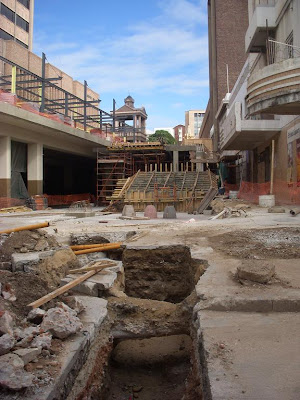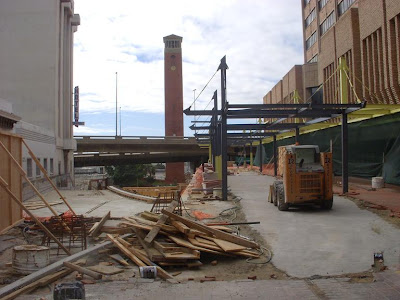22 November 2010
Change of direction
27 June 2010
World Cup action



At each match, official flags of the two competing teams flank the Fifa flag.





With about half an hour till kick-off, the stand fills up nicely.

Even during practice ahead of the game, Wayne Rooney battled to get the ball into the back of the net. But, in truth, he had a fine game, hitting the upright and setting up several other goal-scoring opportunities.

The nationl flags are taken onto the pitch ahead of the national anthems.
 The game was played in perfect conditions, as reflected in the gentle pink clouds above the stadium shortly before sunset.
The game was played in perfect conditions, as reflected in the gentle pink clouds above the stadium shortly before sunset. Before heading for the stadium on Saturday, we visited the refurbished Donkin Reserve, where this giant SA flag, measuring 12m by 8m was flying.
Before heading for the stadium on Saturday, we visited the refurbished Donkin Reserve, where this giant SA flag, measuring 12m by 8m was flying. Even the navy was present, with a frigate spotted in Algoa Bay, while tourists enjoy a hands-on sculpture by Anton Momberg on the Donkin Reserve.
Even the navy was present, with a frigate spotted in Algoa Bay, while tourists enjoy a hands-on sculpture by Anton Momberg on the Donkin Reserve. A kuduzela - a vuvuzela shaped like the horn of a kudu - and guitar are among the colourful items used by these fans pictured on the big screen during the build-up.
A kuduzela - a vuvuzela shaped like the horn of a kudu - and guitar are among the colourful items used by these fans pictured on the big screen during the build-up. Ref's turn again. The ref and linesmen join the Koreans during warm-up.
Ref's turn again. The ref and linesmen join the Koreans during warm-up. The mascot Zakumi, which took something of a back seat to the ubiquitous vuvuzelas, was the fun toy of this young fan, while her dad took pictures of the momentous occasion.
The mascot Zakumi, which took something of a back seat to the ubiquitous vuvuzelas, was the fun toy of this young fan, while her dad took pictures of the momentous occasion. Reminding fans of that epic opening concert at Orlando Stadium, during the build-up snatches of Shakira singing Waka Waka were shown.
Reminding fans of that epic opening concert at Orlando Stadium, during the build-up snatches of Shakira singing Waka Waka were shown.06 June 2010
5 days to go





 Landscaping of the surrounds includes this unique paving stone encircling the newly planted tree. Lights are astride to light up the trees for night matches.
Landscaping of the surrounds includes this unique paving stone encircling the newly planted tree. Lights are astride to light up the trees for night matches. Ticket retrieval and searching. The excitement will palpable in this set of narrow passages come match days.
Ticket retrieval and searching. The excitement will palpable in this set of narrow passages come match days. FIFA signage on the entrance. The walkway towards the entrance is paved and well lit, and increases the anticipation a notch before walking into the bowl.
FIFA signage on the entrance. The walkway towards the entrance is paved and well lit, and increases the anticipation a notch before walking into the bowl.29 May 2010
Gearing up for Sepp
 Brick paving galore characterises the main entrance to the stadium in Alfred Road, which saw final preparations yesterday ahead of Sepp Blatter's visit.
Brick paving galore characterises the main entrance to the stadium in Alfred Road, which saw final preparations yesterday ahead of Sepp Blatter's visit. This area was a dusty wasteland last time we visited. Now it has been grassed and looks a lot cooler.
This area was a dusty wasteland last time we visited. Now it has been grassed and looks a lot cooler. A view of the Milner Avenue entrance, which shows there are still some ugly areas to be patched up. We also noticed that lights have been installed along the length of Milner Avenue and up Gibaud Road, with a new walkway on the northern side of the lake nearing completion and the road being widened. Should be ready by June 13, when the first match is held in Port Elizabeth.
A view of the Milner Avenue entrance, which shows there are still some ugly areas to be patched up. We also noticed that lights have been installed along the length of Milner Avenue and up Gibaud Road, with a new walkway on the northern side of the lake nearing completion and the road being widened. Should be ready by June 13, when the first match is held in Port Elizabeth. Further afield, we took a look at the St George's Park cricket stadium, scene for the city's Fan Park - and found this poster with a plan of the ground dating back to the 2003 ICC World Cup. There was, in fact, no visible sign, outside the stadium, of preparations for the fan park.
Further afield, we took a look at the St George's Park cricket stadium, scene for the city's Fan Park - and found this poster with a plan of the ground dating back to the 2003 ICC World Cup. There was, in fact, no visible sign, outside the stadium, of preparations for the fan park.+-+Copy.JPG) Nice view. When Sir Rufane Donkin named the tiny village below him Port Elizabeth, after his late wife, in 1820, he stood on an area he proclaimed public open space in perpetuity. The Donkin Reserve is being upgraded, and this statue is one of 67 art works being installed on a Mandela Walk - or "Route 67" - named after his 67 years of public service. This will lead from the 1923 Campanile (marking the British Settlers' arrival in 1820) and across the Donkin.
Nice view. When Sir Rufane Donkin named the tiny village below him Port Elizabeth, after his late wife, in 1820, he stood on an area he proclaimed public open space in perpetuity. The Donkin Reserve is being upgraded, and this statue is one of 67 art works being installed on a Mandela Walk - or "Route 67" - named after his 67 years of public service. This will lead from the 1923 Campanile (marking the British Settlers' arrival in 1820) and across the Donkin. A road, Jetty Street, once ran along here, next to the Market Square. It was subsequently covered to form a bus terminus, with the Campanile Hotel on the right suffering as a result. Now they have removed some of that concrete and are building a showpiece staircase linking Strand Street to the Market Square.
A road, Jetty Street, once ran along here, next to the Market Square. It was subsequently covered to form a bus terminus, with the Campanile Hotel on the right suffering as a result. Now they have removed some of that concrete and are building a showpiece staircase linking Strand Street to the Market Square.
















.JPG)








